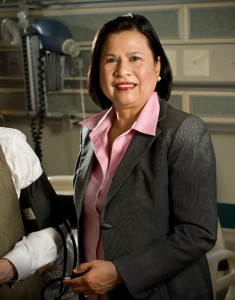
Ilagen (pictured) and Kaylor hope that their research will help seniors manage their blood pressure.
((The following article appeared in the Spring 2012 issue of the Wright State University Magazine.))
The computer in Perla Ilagan’s office was giving off the familiar “ding” tone. It signaled that an elderly participant in a Wright State University College of Nursing and Health study had just taken her blood pressure on a machine at a senior center in rural Ohio.
Ilagan caught her breath. The reading was much higher than expected—so high that Ilagan immediately called the center and asked to speak to the woman.
The woman came to the phone and told Ilagan she had an explanation for the higher-than-normal reading.
“When I lose in euchre,” she said, “I get upset.”
Much to Ilagan’s relief, the woman’s anger over the card game quickly subsided and her blood pressure returned to lower, safer levels.
But the incident illustrated the effectiveness of the study, which was to see if the placement of self-administering blood-pressure machines at senior centers in underserved rural areas would result in closer monitoring and better treatment for elderly residents.
The study was conducted by assistant professor Mary Beth Kaylor, Ph.D., and project director Diane Mehling, assistant director of the Nursing Institute of West Central Ohio, along with Ilagan, Ph.D, also an assistant professor. The three partnered with the Washington, D.C.-based American Association of Home Services for the Aging (now Leading Age).
“It helped our elderly take more ownership and control of their health,” said Ilagan. “If instituted, the program would help better manage hypertension and improve the quality of life for our elderly.”
High blood pressure, or hypertension, affects more than two out of three people older than 75. It can increase the chances of stroke and death from cardiovascular causes.
The 10-month pilot study, which concluded in April 2011, was funded from a $399,919 grant from the Agency for Healthcare Research and Quality, of which Wright State received $173,897. AHRQ, part of the U.S. Department of Health and Human Services, supports research designed to improve the quality of health care and broaden access to services.
The Telehealth Kiosk machines were supplied by the Canada-based Healthanywhere company. The machines consist of blood-pressure monitoring equipment tethered to a computer using a Bluetooth-enabled monitor that can instantly send readings back to a central server manned by the Wright State study team.
In trying to decide how best to deploy the machines in rural areas, the team determined that senior centers would be ideal since elderly people gather there in numbers on a regular basis.
Machines were placed at centers in Urbana and Bellefontaine, Ohio, and control groups without machines were developed at centers in Miamisburg and Spring Valley. About 120 older adults with hypertension participated.
Some of the elderly participants were slow to warm up to the machines because they were unfamiliar with computers and feared they might break them. But as the study unfolded, the participants were soon using the machines to take their blood pressure at least once a week, comfortably.
“I didn’t expect to get that level of acceptance,” Kaylor said. “A lot of them were very excited to learn new technology.”
If the participants’ blood pressures deviated from what was expected, the Wright State team would immediately follow the customized protocols from participants’ primary care physicians. Depending on the readings, the participants would be told to either go to a hospital emergency room, immediately see their doctor, or make an appointment to see their doctor within five days.
Having regular weekly readings was superior to the twice-a-year blood pressure checks at doctors offices, which can also result in “white coat hypertension”—the tendency for some people’s blood pressure to shoot up when it is measured by a doctor.
“And what they don’t see are those spikes that happen on a weekly or daily basis,” Ilagan said.
In addition, the machine-computer setup enabled the Wright State team to quickly advise the participant on what to do.
At the beginning and conclusion of the study, blood pressures were taken of all of the participants. The ones who used the blood-pressure machines had an overall greater reduction in blood pressure than those in the control group.
In addition, a half dozen residents who used the machines had their blood-pressure prescriptions changed as a result of the increased monitoring.
The Wright State team is hoping that the Agency for Healthcare Research and Quality is persuaded enough by the study to warrant a larger clinical trial and eventually deploy the machines to rural senior centers on a permanent basis.
Kaylor would like to do a larger study as well as investigate the economic feasibility of installing the machines at senior centers and perhaps connecting them directly to doctors’ offices.
But even if none of this happens, Ilagan said, the study yielded multiple benefits.
“We determined it can be done and it can be done on a larger scale,” she said. “It controlled blood pressures through closer monitoring. The participants learned how to use technology. And they took ownership of their health maintenance.”
Kaylor is convinced that deploying blood pressure machines in senior centers would pay off.
“If there is a chance you could save one person, or prevent one stroke, or prevent one heart attack, that’s worth it,” she said.

 Milling around
Milling around  Wright State recognizes Nursing Professor Kim Ringo for advancing international student success
Wright State recognizes Nursing Professor Kim Ringo for advancing international student success  Wright State honors graduating students for distinguished doctoral dissertations
Wright State honors graduating students for distinguished doctoral dissertations  Top 10 Newsroom videos of 2025
Top 10 Newsroom videos of 2025  Museum-quality replica of historic Hawthorn Hill donated to Wright State
Museum-quality replica of historic Hawthorn Hill donated to Wright State 